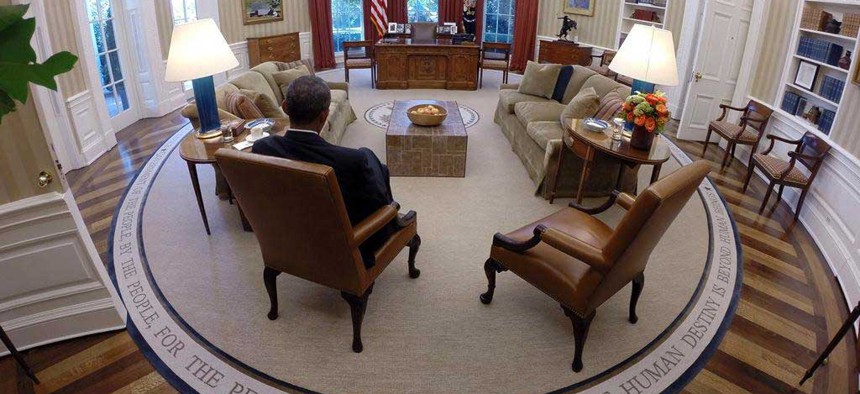
President Obama reads briefing material in the Oval Office, on August 29, 2014. White House photo by Pete Souza
Behind Obama's Hesitation on Syria
Obama's caution reflects both the lawyer that he is and a deliberate turn away from his predecessor, who often neglected to weigh all the consequences of his decisions. By George F. Condon, Jr.
The immediate focus after President Obama's press conference Thursday was his unartful declaration that he doesn't yet have a strategy for the terrorist group sweeping through Iraq and controlling parts of Syria. But the main message he conveyed was much larger than any semantic squabble: This is a president who is not going to be hurried in his response to daily developments. He is not going to be stampeded into a military strike either by horrific videos of executions and beheadings or by growing complaints from political foes who say action is overdue.
That caution reflects both the lawyer that Obama is and a continuing revulsion to the style of his predecessor, who saw himself as "the decider" while often not taking the time to weigh all the consequences.
In some ways, the flap over what Obama said about strategy is a sideshow. It is clear from his overall comments that he has what he sees as a strategy for defeating the terrorists, one that relies on close coordination with other regional powers and with American allies, all of whom he said he is including in the discussions building up to next week's NATO summit in Wales.
What he doesn't have yet is the military plan. That, he said, will come after Defense Secretary Chuck Hagel and the Joint Chiefs of Staff produce "a range of options." He added, "I'll be meeting with my National Security Council again this evening as we continue to develop that strategy." When the president receives those options, he will assess how they fit into the existing overall strategy for the region, according to White House aides who scrambled Thursday evening to clarify what the president said.
Without question, he could have made that clearer in his remarks. Now, after his performance in the White House Briefing Room, the main challenge to the president is to demonstrate that he is not suffering from paralysis by analysis, lest he confirm James Carville's lament that Democrats too often "see six sides to the Pentagon." Obama must show that concrete action will emerge from this process. But the impetus for coming out to talk to reporters seemed to be to slow down the speculation that anything is imminent.
"I don't want to put the cart before the horse," he said. "And in some of the media reports, the suggestion seems to have been that, you know, we're about to go full-scale on an elaborate strategy for defeating ISIL. And the suggestion, I guess, has been that we'll start moving forward imminently and somehow Congress, still out of town, is going to be left in the dark. That's not what's going to happen."
Instead, he outlined a process that has a place for both Congress and the broader public. Because he said what emerges as the response to the terrorists will have what he called "a military aspect" and "may cost some money." He promised continued consultations with Congress because "it'll be important for Congress to weigh in." And he pledged that he will make sure "that the American people are part of the debate."
The White House calculation is that, in the end, both Congress and the people will appreciate a process that ponders the full consequences before the bombs fall—in contrast to a comment on Tuesday by one of the neo-con backers of the Bush administration's military plunge into Iraq. Bill Kristol, speaking to conservative commentator Laura Ingraham, was mocking the suggestion that "we can't just bomb" the ISIS radicals. "Why don't we just [bomb]? We know where ISIS is," said Kristol. "What's the harm of bombing them at least for a few weeks and seeing what happens?"
However you define the word, that is not Obama's idea of a strategy.
